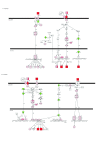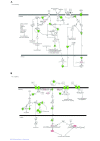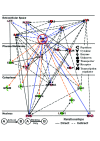Gene network and pathway analysis of bovine mammary tissue challenged with Streptococcus uberis reveals induction of cell proliferation and inhibition of PPARgamma signaling as potential mechanism for the negative relationships between immune response and lipid metabolism
- PMID: 19925655
- PMCID: PMC2784807
- DOI: 10.1186/1471-2164-10-542
Gene network and pathway analysis of bovine mammary tissue challenged with Streptococcus uberis reveals induction of cell proliferation and inhibition of PPARgamma signaling as potential mechanism for the negative relationships between immune response and lipid metabolism
Abstract
Background: Information generated via microarrays might uncover interactions between the mammary gland and Streptococcus uberis (S. uberis) that could help identify control measures for the prevention and spread of S. uberis mastitis, as well as improve overall animal health and welfare, and decrease economic losses to dairy farmers. The main objective of this study was to determine the most affected gene networks and pathways in mammary tissue in response to an intramammary infection (IMI) with S. uberis and relate these with other physiological measurements associated with immune and/or metabolic responses to mastitis challenge with S. uberis O140J.
Results: Streptococcus uberis IMI resulted in 2,102 (1,939 annotated) differentially expressed genes (DEG). Within this set of DEG, we uncovered 20 significantly enriched canonical pathways (with 20 to 61 genes each), the majority of which were signaling pathways. Among the most inhibited were LXR/RXR Signaling and PPARalpha/RXRalpha Signaling. Pathways activated by IMI were IL-10 Signaling and IL-6 Signaling which likely reflected counter mechanisms of mammary tissue to respond to infection. Of the 2,102 DEG, 1,082 were up-regulated during IMI and were primarily involved with the immune response, e.g., IL6, TNF, IL8, IL10, SELL, LYZ, and SAA3. Genes down-regulated (1,020) included those associated with milk fat synthesis, e.g., LPIN1, LPL, CD36, and BTN1A1. Network analysis of DEG indicated that TNF had positive relationships with genes involved with immune system function (e.g., CD14, IL8, IL1B, and TLR2) and negative relationships with genes involved with lipid metabolism (e.g., GPAM, SCD, FABP4, CD36, and LPL) and antioxidant activity (SOD1).
Conclusion: Results provided novel information into the early signaling and metabolic pathways in mammary tissue that are associated with the innate immune response to S. uberis infection. Our study indicated that IMI challenge with S. uberis (strain O140J) elicited a strong transcriptomic response, leading to potent activation of pro-inflammatory pathways that were associated with a marked inhibition of lipid synthesis, stress-activated kinase signaling cascades, and PPAR signaling (most likely PPARgamma). This latter effect may provide a mechanistic explanation for the inverse relationship between immune response and milk fat synthesis.
Figures





References
Publication types
MeSH terms
Substances
Grants and funding
LinkOut - more resources
Full Text Sources
Molecular Biology Databases
Research Materials
Miscellaneous

